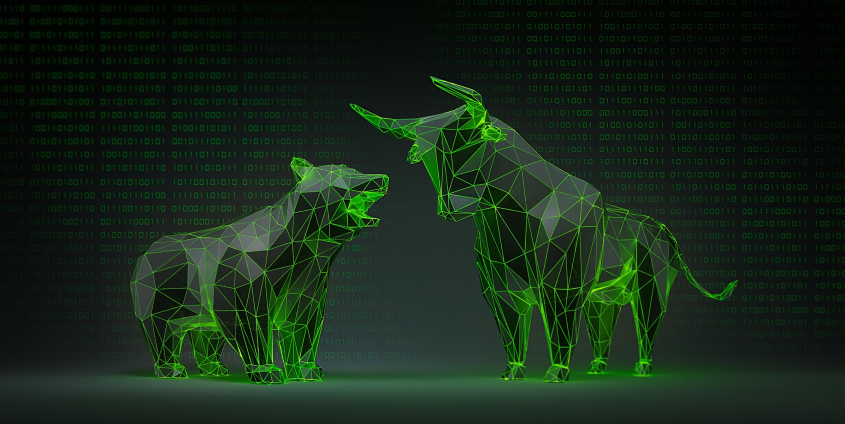Getting rich with crypto?
It’s easy to set up: Download the app, verify your identity, deposit “real money” and get started. Today, it is easier than ever for private individuals to trade in crypto projects. We talked to Alexander Brauneis about the conditions that might perhaps lead to success.
Twenty years ago investors needed a bank to buy shares. Nowadays, anyone can trade cryptocurrencies using a smartphone app. Do people take advantage of this option?
The first crypto exchanges appeared ten years ago. Several million euros were moved there every day. Today the turnover in crypto exchanges alone amounts to up to 200 billion euros a day. In other words, we are talking about colossal turnovers, and the reason for this can only be that more people have indeed joined in on this trade.
How do you explain the huge popularity?
On the one hand, there are now a large number of crypto assets besides Bitcoin. Many of these projects do not only aim to facilitate payment transactions, but also have other advantages or potential benefits. Many people recognise that. In addition, over the past ten years we have seen repeated hype phases, most recently in 2013, 2017 and 2021. During these phases, media targeted at the general public have also reported that the value of Bitcoins has increased significantly. This creates a feeling in the minds of market participants that we call FOMO – fear of missing out. People are worried about missing out on something. This has fuelled the growth of the market, although we are currently going through a period of losses and considerable uncertainty yet again.
Do private investors have a realistic chance of making a profit on the crypto exchanges? After all, success often depends on having an information advantage. Are there deliberate efforts to manipulate prices?
The market has grown too big to be easily tampered with. In my perception, the big cryptocurrencies like Bitcoin or Ether are particularly difficult to manipulate.
What is the role of financial influencers?
We are currently investigating the question of what happens to the prices of very small cryptocurrencies when they are promoted on YouTube by channels that have a few hundred thousand followers. Our results show that the price rises the next day, but then drops again two days later. In this setting, we believe that some manipulation is going on.
What about very large market participants? Do they have more powerful means of control?
Yes, there are the so-called ‘whales’. They can move large amounts of money and thus also drive up prices. But for the big crypto projects, it is similar to the financial market: We assume that the market is efficient and that no one has the power to systematically influence prices over a longer period of time. For instance, this summer we saw one of the top ten cryptocurrencies collapse completely – from 100 dollars to zero. Nobody anticipated this and in the course of this event, major institutional investors also lost a lot of money.
Let’s get back to the private investors. They often trade products on the crypto exchanges that they do not understand. There is a stock market adage: “Only buy what you understand”. Does that also apply to crypto projects?
Yes, definitely.
How can these complex products be explained?
Let’s cast our gaze back to the 1990s. Back then, the Internet was a revolutionary technology that many believed in. Those who bet on today’s most successful market participants, such as Microsoft, Apple or Google, will have made a lot of money with their shares. It is similar with crypto projects. They are based on a new technology, namely blockchain. Blockchain should be understood as a decentralised database that is managed by an egalitarian collective. It is only ever expanded and never modified retrospectively. I assume that this is a technology that will penetrate many areas of life in the next ten years.
But how can I tell which crypto projects will be successful in ten years’ time?
It is difficult to predict whether today’s big players will also be big players in ten years’ time. Therefore, I have to weigh my expectation in the benefits of a new technology, and for that I ideally also have to understand the technology. If a person does not (fully) understand this and still wants to own cryptocurrencies, I would recommend starting with Bitcoin only and only investing in other projects once you understand what the difference and the added value are.
So you invest in a technology and not in a currency?
Most crypto assets are not means of payment in the sense of money. The second largest project is Ethereum – a platform that can be used to build business models. Let me give you a simple example: I can use the Ethereum blockchain to create and trade NFTs (non-fungible tokens). As an artist, I can then tokenise my (electronic) art on the blockchain, thus creating digital proof of ownership and making my art tradable. In order to use the blockchain, I need the currency – in this case Ether. I pay the platform to make the creation of my tokenised art possible.
But this art only has a price if someone is willing to buy it.
Yes, it’s just like any other market. Here, too, we have the principle of supply and demand.
In your opinion, what other promising applications of blockchain technology exist?
Let’s take supply chains: The crypto project VeChain wants to map supply chains on the blockchain. Louis Vuitton already uses this technology. The bag is manufactured – and a record is kept on the blockchain of where the leather comes from and where it is produced. The bag is then shipped, comes to a distributor and finally to the retail shop. All these steps are recorded on the blockchain. They can no longer be deleted, changed or manipulated. There is a chip in the bag that I can use to reconstruct the supply chain. There are also numerous other ideas and projects, such as blockchain-based games, decentralised data storage, payment transactions, databases, the Internet of Things and many more.
Can you explain the underlying concept of decentralisation?
The idea is to create a network without central authority. With blockchains, I don’t have to trust that someone with sovereign authority will act on my behalf, for example that my principal bank will actually let me pay the electricity bill online. In the crypto world, there are no such central authorities. To ensure that transactions, e.g. the transfer of Bitcoins to another address, are nevertheless possible and are always legal, participants – the ‘miners’ – are given economic incentives in the Bitcoin network. They first check whether a desired transaction is legitimate, i.e. whether the sender has the funds in the first place and is not using them twice, i.e. is sending them to two recipients at the same time. Miners are rewarded for this work and fined otherwise; this is called the ‘consensus mechanism’, and there are different versions of this depending on the blockchain. All in all, miners act in their best interest and in my best interest at the same time, without the need for a supervisory authority – in other words, they act in a decentralised manner.
How have key players in the financial market reacted to this new principle to date?
Countries are trying to establish regulation. The EU is currently working on a new directive for crypto assets, and in India crypto assets are now taxed like other financial products. In China, crypto mining has been banned. As far as the financial industry is concerned, the central topic at the moment is so-called decentralised finance (DeFi). For example, people would like to process the trading of various assets, including conventional shares, but also the deposit/loan business on a blockchain basis. All of this is currently still in its infancy and is susceptible to errors, but it can already be offered at very favourable prices.
How can private individuals prepare themselves for a changing financial world? In your opinion, are people adequately financially literate?
The math is relatively simple: If I want a higher return, I have to take greater risks. With high inflation rates and low interest rates on savings, people are taking risks that they are often unable to gauge. There are many financial products that are much safer than cryptocurrencies when it comes to building up assets wisely. However, crypto projects could also be considered as an add-on.
Given that cryptocurrencies are now experiencing difficulties, couldn’t we just wait for prices to improve?
If I invest in an Austrian ATX company that has been around for a long time, odds are that the company will still be doing well in ten or twenty years. I can’t say the same for cryptocurrencies. Trading via smartphone app doesn’t usually make you a millionaire either, although isolated cases do occur. Even if large providers such as Bitpanda only offer around 50 of the more ‘stable’ currencies of the approximately 15,000 different cryptocurrencies for trading, the following still holds true: trading is very risky. No one can offer recommendations and you have to be able to assess the risk yourself.
For ad astra: Romy Müller
About Alexander Brauneis
Alexander Brauneis is an Associate Professor at the Department of Financial Management at the University of Klagenfurt. He will join Nottingham Business School as Professor for Finance and Innovation from November 2022. He will continue to be associated with the University of Klagenfurt as an external lecturer. He studied Business Administration at the University of Graz and was a member of the research staff at AAU from 2004. In 2014, he was awarded the venia docendi for the subject ‘General Business Administration’. His research interests include empirical and quantitative financial market research, applied econometrics, cryptocurrencies and the market microstructure of crypto markets.










 © peterschreiber.media/adobe.stock.com
© peterschreiber.media/adobe.stock.com

